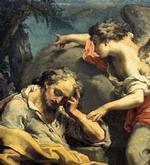Catholic Activity: Feast of St. Andrew, November 11
Father Francis Weiser explains the Church's traditions and customs related to this day.
DIRECTIONS
Andrew (November 30) — This Apostle was the brother of Saint Peter and one of the first disciples of Christ (John 1, 40-42). After the Lord's Resurrection and Ascension, when the Apostles dispersed on their missionary journeys, Andrew is reported by tradition to have preached in the countries south of the Black Sea; then he came to Greece, where he was martyred for Christ under the Emperor Nero, in A.D. 60. He died on a diagonally transversed cross which the Romans sometimes used for executions, and which came to be called St. Andrew's cross.
Saint Andrew's Night is a traditional time of "oracles" for girls who pray to the Saint for a husband and wish to receive some visible assurance that their prayers have been heard. The origin of this custom is explained by the name Andrew (best translated as "manly" or "man") and by the fact that from ancient times he has been called the "most kindly of saints." Others have found the reason for this patronage in the antiphon of the Divine Office on Andrew's Day: Concede nobis hominem justum (Grant us a good, just man). Whichever the reason, the fact is that Saint Andrew was invoked in all countries by young women looking for a husband. Much of this lore is still practiced in Europe.
On Andrew's Night girls pour spoonfuls of molten lead or wax into cold water, and the shape of the congealing portions is supposed to reveal details of their future love and marriage. In the western sections of Austria and in other Alpine countries young men and girls fasten a very small candle into a nutshell and put these little "boats" into a trough filled with water. All other lights are then extinguished and only the tiny flames of the candles sparkle in the darkened room. By blowing against them, the nutshells are made to move across the water. When the lights of a boy and a girl collide without capsizing, it is taken as a sign that the two will fall in love and marry. In Poland girls put bones from the remnants of a meal in front of the door. The girl whose bone the dog takes first will be the first one to marry.
Before going to bed on Andrew's Night girls say a prayer to the Saint asking him to show them their future husband in their dreams. Saint Andrew was always considered very kind and generous in this matter, even to the extent that he himself would procure the right man for a girl whose own efforts had not been successful. Here is such a prayer-poem from the Tirol:
Heavenly patron, Saint Andrew dear, Please won't you show me a picture clear Of the man whom thou hast chosen for me? Whether he handsome or homely be, Or young in years, or maybe old, Or still and shy, or loud and bold; I do not mind his manner and way: Just make him love me, that's all I pray.LITURGICAL PRAYER: We humbly beseech Thy majesty, O Lord, that Saint Andrew, who was both a preacher and ruler of Thy holy Church, may also be a constant intercessor for us with Thee.
Activity Source: Holyday Book, The by Francis X. Weiser, S.J., Harcourt, Brace and Company, Inc., New York, 1956






